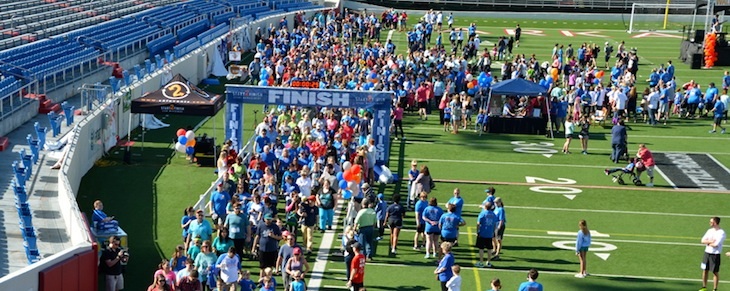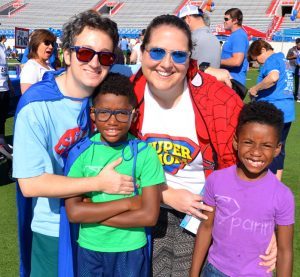Former foster child raises $10,000 to end others’ waiting, event raises more than $260,000
by May 6, 2017 5:00 pm 1,419 views

The fifth annual Walk for the Waiting event was held Saturday (May 5) at War Memorial Stadium.
Six years ago, Hannah Cranford was a foster kid whose mother’s parental rights had been terminated and who was being adopted by a loving family. This year, she raised more than $10,000 to help more kids have stories like hers.
Hannah, 15, was one of the top money-raisers at the fifth annual Walk for the Waiting May 5 at War Memorial Stadium. The event raises money and awareness about three organizations: The CALL in Arkansas,which recruits and trains foster and adoptive parents; Project Zero, which links prospective parents and children in need of homes; and Immerse Arkansas, which serves young people who are aging out of the system without finding a permanent home.
The organizations seek to serve the 5,155 Arkansas children stuck in the state’s foster care system, including 500 who are eligible to be adopted through the state, 200 of whom are already in pre-adoptive homes.
Foster children are those whom the state’s Division of Children and Family Services temporarily has removed from their biological families because of abuse, drug abuse and other challenges. The goal is to return the children to their biological families. When the courts determine they cannot be returned, rights are terminated and they become eligible for adoption.
According to event organizer Kandace Gerber, the walk attracted 1,200 to 2,000 participants, and there were more than 300 entrants in a 5K race. As of the afternoon of May 5, the event had raised $260,822 of a $300,000 goal. Hannah had raised $10,127 of that amount and has been a leading fundraiser in years past.
“I once was a foster kid just as many others, and I just felt like I needed to do something to help foster kids have a home and not have to wait many years or months,” she said from a spot near the back of the end zone at the stadium. “I just didn’t want them to wait forever to find a family and grow up without one.”
Cranford was adopted by David and Becky Cranford in 2011 when she was nine years old. The Cranfords, who never had biological children, began fostering 10-12 years ago while in their 40s and took Hannah into their home as a foster child. Like all fostering situations, it was supposed to be temporary, but after two-and-a-half years the judge terminated her mother’s rights.
“We’re walking out of the court and her caseworker said, ‘Well, are y’all going to adopt her?’ And we said, ‘I don’t know. Ten minutes ago, the goal was to reunify with her mother,’” David Cranford said. “But I said, ‘Can’t imagine not. We love her, and we’re not going to be the next set of adults that kick her to the curb. So we did. They fast-tracked the adoption, and she’s our daughter.”

Hannah has a number of interests. She has a microscope and calls herself “a pretty big science nerd sometimes.” She likes to cook and might someday own a restaurant.
Unlike Hannah, many children age out of the system without ever being adopted, and that’s where Immerse Arkansas steps in. That organization provides services – housing, mentoring, a drop-in center – to about 25-30 youth. Executive Director Eric Gilmore said young people who age out of the system lack resources, housing, money and jobs.
“But the big hurt is a lot of times, they’re on their own,” he said. “It’s a lack of relationships that can be the biggest barrier. So who do you call when you need help? Who do you call if you run out of money, you can’t pay a bill, or you have a flat tire, or you need to learn how to cook a meal?”
As a result, many experience homelessness or commit crimes or are victims of crimes, few enroll in college, and many become pregnant before they are ready. Gilmore said his organization tries to surround them with people who care about them. The key to success is having one person who won’t give up on them.
“They are trying to be hopeful,” he said. “So a lot of times, they have a lot of reason to have given up on hoping that things could be different from how they are, but still they’re willing to give it a try and see if it can’t be different.”
Christie Erwin, the founder and director of Project Zero, last year saw her group help 125 children find permanent homes – a big jump from 2015, when the number was 78.
Not every story has an ideal ending. The day before the Walk for the Waiting, she was asked by a 17-year-old, who’s been waiting since 2009, if he’d ever be adopted. That disheartening conversation occurred on Friday. Then on Saturday just before the event, Erwin spoke with a mother who had attended a Project Zero event in January to meet one girl – who had four siblings.
“They prayed it through and talked it through, and last weekend was their first weekend as a family of 10,” she said. “They have three biological children, and they’ve just added five additional children to their home as a result of one little event where they met one little girl.”
Some children have to wait until they are older to find a permanent family; some find one much sooner. Kenneth and Miles Spann, ages 8 and 7, were adopted at ages 5 and 4 by Jeremy and Elizabeth Spann, who saw their pictures on the Project Zero website and fell in love with their smiles.
The couple had tried infertility treatments without success and instead decided to adopt through the Division of Children and Family Services. For them, the process has been surprisingly unchallenging. The young men are understanding and resilient. The parents are white while their sons are African-American, but it’s not an issue. Elizabeth Spann said while they do get some stares in stores, most people are very supportive, and African-American friends have taught her how to fix her sons’ hair.
The Spanns try to help their sons see their stories as something to celebrate.
“We do a lot of things with superheroes,” she said. “We always tell them, you know, Batman was adopted, Superman was adopted, Spiderman was adopted, so we always kind of talk about that. So talking to them about their origin story as a superhero is important. And they’re little, so we try to figure out how much to tell them at a time.”
